This document discusses support vector machines (SVMs) for classification tasks. It describes how SVMs find the optimal separating hyperplane with the maximum margin between classes in the training data. This is formulated as a quadratic optimization problem that can be solved using algorithms that construct a dual problem. Non-linear SVMs are also discussed, using the "kernel trick" to implicitly map data into higher-dimensional feature spaces. Common kernel functions and the theoretical justification for maximum margin classifiers are provided.


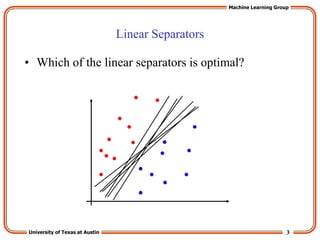
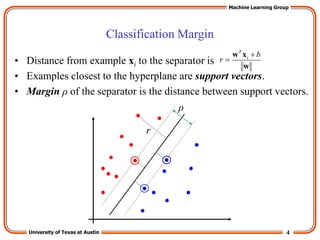
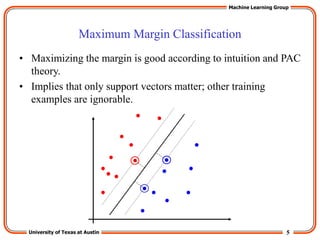


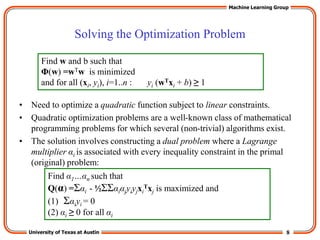




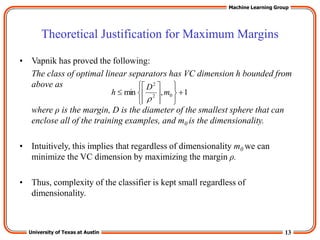
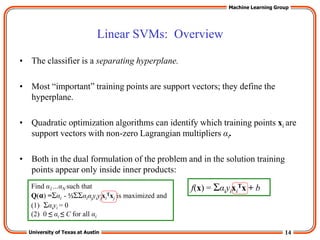
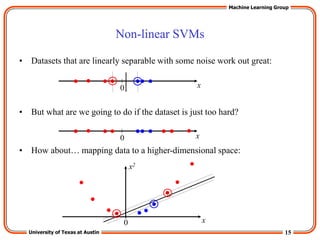
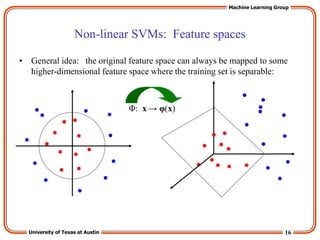
![17
University of Texas at Austin
Machine Learning Group
The “Kernel Trick”
• The linear classifier relies on inner product between vectors K(xi,xj)=xi
Txj
• If every datapoint is mapped into high-dimensional space via some
transformation Φ: x → φ(x), the inner product becomes:
K(xi,xj)= φ(xi) Tφ(xj)
• A kernel function is a function that is eqiuvalent to an inner product in
some feature space.
• Example:
2-dimensional vectors x=[x1 x2]; let K(xi,xj)=(1 + xi
Txj)2
,
Need to show that K(xi,xj)= φ(xi) Tφ(xj):
K(xi,xj)=(1 + xi
Txj)2
,= 1+ xi1
2xj1
2 + 2 xi1xj1 xi2xj2+ xi2
2xj2
2 + 2xi1xj1 + 2xi2xj2=
= [1 xi1
2 √2 xi1xi2 xi2
2 √2xi1 √2xi2]T [1 xj1
2 √2 xj1xj2 xj2
2 √2xj1 √2xj2] =
= φ(xi) Tφ(xj), where φ(x) = [1 x1
2 √2 x1x2 x2
2 √2x1 √2x2]
• Thus, a kernel function implicitly maps data to a high-dimensional space
(without the need to compute each φ(x) explicitly).](https://image.slidesharecdn.com/supportvectormachine-221212054922-397aed1a/85/Support-Vector-Machine-ppt-17-320.jpg)
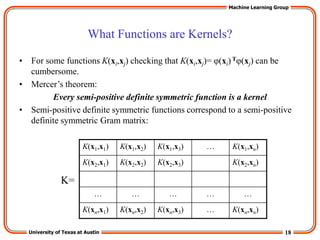


![21
University of Texas at Austin
Machine Learning Group
SVM applications
• SVMs were originally proposed by Boser, Guyon and Vapnik in 1992 and
gained increasing popularity in late 1990s.
• SVMs are currently among the best performers for a number of classification
tasks ranging from text to genomic data.
• SVMs can be applied to complex data types beyond feature vectors (e.g. graphs,
sequences, relational data) by designing kernel functions for such data.
• SVM techniques have been extended to a number of tasks such as regression
[Vapnik et al. ’97], principal component analysis [Schölkopf et al. ’99], etc.
• Most popular optimization algorithms for SVMs use decomposition to hill-
climb over a subset of αi’s at a time, e.g. SMO [Platt ’99] and [Joachims ’99]
• Tuning SVMs remains a black art: selecting a specific kernel and parameters is
usually done in a try-and-see manner.](https://image.slidesharecdn.com/supportvectormachine-221212054922-397aed1a/85/Support-Vector-Machine-ppt-21-320.jpg)